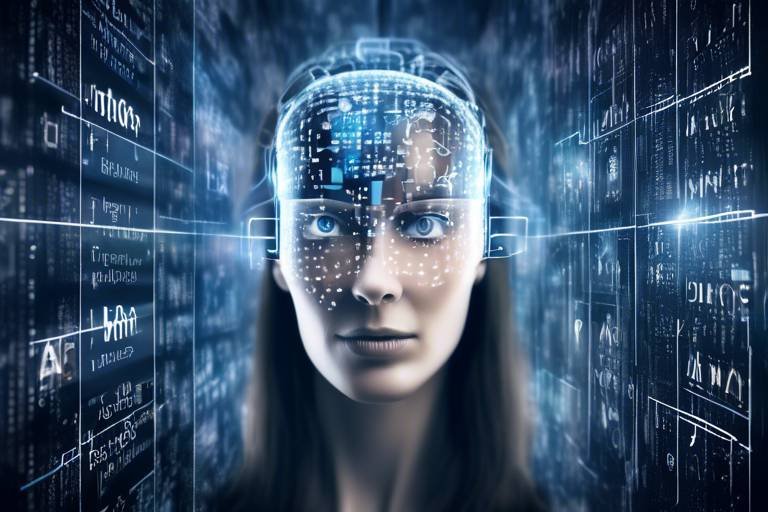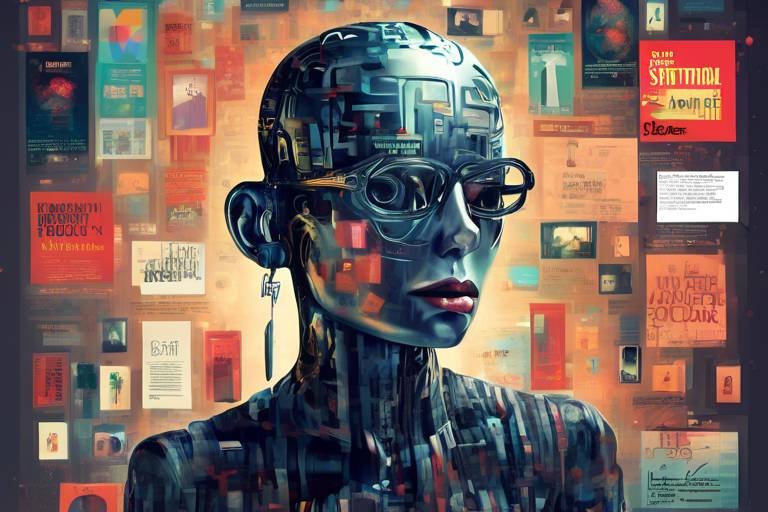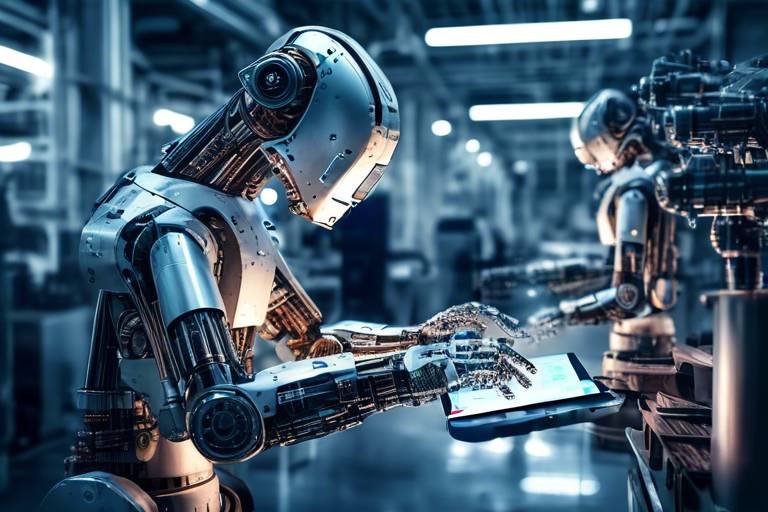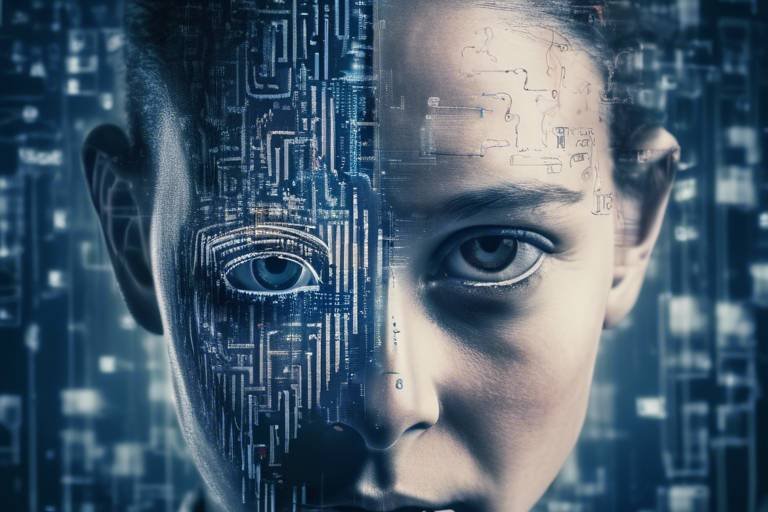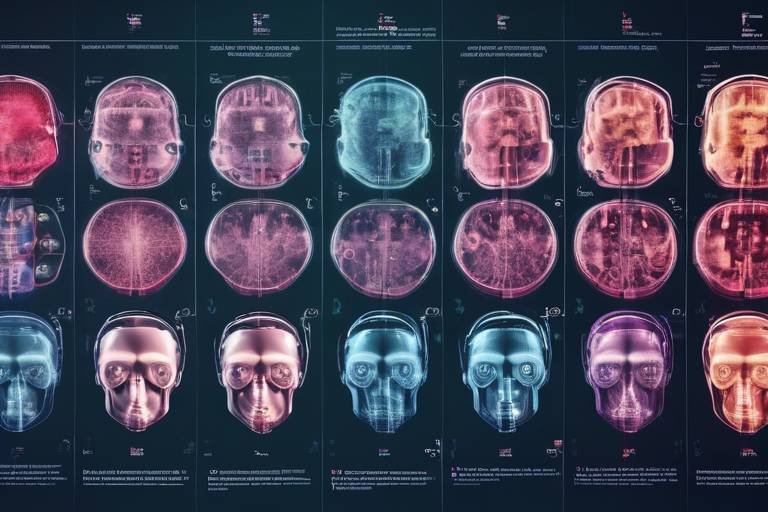Quantum Machine Learning: The Fusion of AI and Quantum Computing
Welcome to the fascinating world of Quantum Machine Learning, where the realms of artificial intelligence and quantum computing collide to create unprecedented opportunities! Imagine a universe where computers can process information at lightning speed, tackling problems that were once thought to be impossible. This is not just a dream; it’s becoming a reality as we delve deeper into the fusion of these two groundbreaking technologies. In this article, we will explore how quantum computing enhances machine learning, paving the way for innovations that could revolutionize industries from healthcare to finance.
At its core, quantum machine learning combines the principles of quantum mechanics with the algorithms of machine learning, resulting in a powerful synergy that can handle vast amounts of data more efficiently than ever before. But what does this really mean? Well, think of it like this: traditional computers are like well-trained librarians, meticulously organizing and retrieving books from a library. Quantum computers, on the other hand, are like magical beings that can simultaneously search through every book in the library at once, drastically reducing the time it takes to find the information you need.
The potential applications of quantum machine learning are immense. From improving the accuracy of predictive models to uncovering hidden patterns in complex datasets, this fusion is set to transform how we approach problems in various fields. For instance, consider the realm of drug discovery. By leveraging quantum algorithms, researchers could analyze molecular interactions at a level of detail that classical computers simply cannot achieve, leading to faster and more effective drug development.
As we embark on this journey through the intricacies of quantum machine learning, we will break down the fundamental concepts of both quantum computing and machine learning. We’ll explore how these technologies work independently and then dive into how their integration can lead to groundbreaking advancements. By the end of this article, you’ll have a clearer understanding of why this intersection is not just a trend but a pivotal moment in the evolution of technology.
- What is quantum machine learning?
Quantum machine learning refers to the combination of quantum computing and machine learning techniques, enabling faster and more efficient data processing. - How does quantum computing differ from classical computing?
Unlike classical computers that use bits to process information, quantum computers use qubits, which can exist in multiple states simultaneously due to superposition. - What are some applications of quantum machine learning?
Applications include drug discovery, financial modeling, image recognition, and more. - Can quantum machine learning solve problems faster than classical methods?
Yes, quantum algorithms can significantly reduce computation times for complex tasks, making previously unsolvable problems tractable.

Understanding Quantum Computing
Quantum computing is a revolutionary approach to processing information that leverages the strange and fascinating principles of quantum mechanics. Unlike classical computers, which use bits as the smallest unit of data (0s and 1s), quantum computers utilize qubits. These qubits can exist in multiple states simultaneously, thanks to a phenomenon known as superposition. This means that a quantum computer can perform a multitude of calculations at once, vastly increasing its computational power compared to traditional systems.
Another critical concept in quantum computing is entanglement. When qubits become entangled, the state of one qubit is directly related to the state of another, regardless of the distance separating them. This unique property allows quantum computers to process complex problems more efficiently than classical computers. Imagine trying to solve a massive puzzle; a classical computer would tackle each piece one at a time, while a quantum computer could analyze many pieces simultaneously, drastically reducing the time needed to find a solution.
To further illustrate the differences between quantum and classical computing, consider the following table:
| Feature | Classical Computing | Quantum Computing |
|---|---|---|
| Data Unit | Bit (0 or 1) | Qubit (0, 1, or both) |
| Processing Power | Linear scaling with more bits | Exponential scaling with more qubits |
| Problem Solving | Sequential processing | Parallel processing |
| Key Principles | Deterministic | Probabilistic (due to superposition and entanglement) |
As we dive deeper into the world of quantum computing, it’s essential to understand how these principles not only enhance computational capabilities but also pave the way for significant advancements in various fields. From cryptography to drug discovery, the applications of quantum computing are vast and varied. But what does this mean for the future of technology? The fusion of quantum computing with other domains, especially artificial intelligence, is where the magic truly happens, leading us to the exciting realm of quantum machine learning.
In conclusion, understanding quantum computing is not just about grasping its fundamental principles; it's about recognizing the potential it holds to transform our world. As we continue to explore this cutting-edge technology, we can only imagine the innovative solutions that will emerge, reshaping industries and enhancing our daily lives.

The Basics of Machine Learning
Machine learning is a fascinating field that has revolutionized how we interact with technology. At its core, machine learning is a subset of artificial intelligence (AI) that enables computers to learn from data and improve their performance over time without being explicitly programmed. Imagine teaching a child to recognize different animals by showing them numerous pictures; similarly, machine learning algorithms learn patterns and make predictions based on the data they are trained on. This ability to learn and adapt is what sets machine learning apart from traditional programming.
There are several fundamental concepts that underpin machine learning, and understanding these is crucial for grasping how this technology works. At a high level, machine learning can be categorized into three main types: supervised learning, unsupervised learning, and reinforcement learning. Each of these categories has its own unique characteristics and applications.
In supervised learning, the algorithm is trained on a labeled dataset, meaning that each training example is paired with an output label. This type of learning is akin to having a teacher guide a student through a subject. For example, if we want to train a model to recognize cats and dogs, we would provide it with numerous images of both animals, each labeled accordingly. The model learns from these examples and can then predict the label of new, unseen images. This method has numerous applications, including:
- Image recognition
- Spam detection in emails
- Predictive analytics in finance
On the other hand, unsupervised learning operates without labeled data. Here, the algorithm tries to identify patterns and relationships within the data on its own, much like a detective piecing together clues. This approach is particularly useful in scenarios where we don’t have predefined categories or labels. Applications of unsupervised learning include:
- Clustering similar items together, such as customer segmentation
- Anomaly detection to identify unusual patterns in data
- Market basket analysis to understand consumer purchasing behavior
Reinforcement learning is another intriguing aspect of machine learning, where an agent learns to make decisions by taking actions in an environment to maximize a reward. This type of learning is inspired by behavioral psychology and is widely used in areas such as robotics and game playing.
To further understand these concepts, let's take a look at a simple comparison of the three types of machine learning:
| Type | Description | Example |
|---|---|---|
| Supervised Learning | Learning from labeled data to make predictions. | Image classification (cats vs. dogs) |
| Unsupervised Learning | Finding patterns in unlabeled data. | Customer segmentation |
| Reinforcement Learning | Learning through trial and error to maximize rewards. | Game playing (e.g., chess) |
As we delve deeper into the world of machine learning, it's essential to recognize that the algorithms used are just as important as the data they are trained on. From decision trees to neural networks, each algorithm has its strengths and weaknesses, making the choice of the right one crucial depending on the task at hand. The beauty of machine learning lies in its versatility and the potential it holds for transforming various industries, from healthcare to finance and beyond.
In conclusion, machine learning is not just a buzzword; it's a powerful tool that has the potential to reshape our world. Whether you're interested in automating mundane tasks or unlocking insights from vast datasets, understanding the basics of machine learning is the first step in harnessing its power. As technology continues to evolve, the possibilities are endless!

Supervised vs. Unsupervised Learning
When diving into the world of machine learning, one of the first things you'll encounter is the distinction between supervised and unsupervised learning. Imagine you're a teacher guiding a group of students versus letting them explore the world on their own. That's essentially the difference! In supervised learning, we provide the model with labeled data, which acts like a teacher giving students the answers to their homework. For instance, if we want to train a model to recognize images of cats, we would feed it thousands of labeled images, clearly stating which ones contain cats and which do not. This way, the model learns to identify patterns and characteristics of cats based on the examples given.
On the flip side, we have unsupervised learning, which is akin to giving students a blank canvas and asking them to figure out what to draw without any guidance. Here, the model is presented with data that lacks labels, and its job is to uncover hidden patterns or structures within that data. This could involve clustering similar items together or identifying anomalies. For example, if we feed a model a dataset of customer transactions without any labels, it might group customers based on purchasing behavior, revealing insights we hadn't considered before.
To further illustrate the differences, let's take a look at a quick comparison:
| Feature | Supervised Learning | Unsupervised Learning |
|---|---|---|
| Data Type | Labeled data | Unlabeled data |
| Goal | Predict outcomes based on input data | Discover patterns and structures |
| Examples | Image recognition, spam detection | Customer segmentation, anomaly detection |
As you can see, both methods have their unique strengths and applications. Supervised learning is fantastic for tasks where we have clear outcomes we want to predict, while unsupervised learning shines in exploratory data analysis, helping us to make sense of complex datasets. The choice between the two often depends on the specific problem at hand and the type of data available.
In essence, understanding the difference between supervised and unsupervised learning is crucial for anyone venturing into the realm of machine learning. Each approach offers valuable insights and capabilities, enabling us to tackle a variety of challenges in innovative ways.
- What is supervised learning? Supervised learning is a type of machine learning where models are trained on labeled datasets, allowing them to learn and predict outcomes based on input data.
- What is unsupervised learning? Unsupervised learning involves training models on unlabeled datasets, where the model seeks to find patterns and relationships within the data without explicit guidance.
- Can you give examples of supervised learning? Common examples include spam detection in emails, image recognition, and predictive analytics in finance.
- What are some applications of unsupervised learning? Applications include customer segmentation, market basket analysis, and anomaly detection in network security.

Applications of Supervised Learning
Supervised learning is a powerful tool in the realm of artificial intelligence, allowing machines to learn from labeled datasets and make predictions based on that knowledge. This approach has found its way into numerous applications across various industries, revolutionizing how we approach problems and enhance efficiency. One of the most prevalent applications is in image recognition. Here, algorithms are trained on thousands of labeled images to identify and classify objects, faces, or even emotions. Imagine the power of a system that can discern whether a photo contains a cat or a dog, or even recognize a person’s face in a crowd. This capability is not just a novelty; it has real-world implications in security and social media platforms.
Another fascinating application is in spam detection. Email services utilize supervised learning algorithms to filter out unwanted messages by analyzing labeled examples of spam and non-spam emails. By continuously learning from incoming data, these systems become increasingly adept at distinguishing between legitimate correspondence and potential threats, keeping our inboxes cleaner and safer. It’s almost like having a digital bouncer that gets better at its job over time!
Predictive analytics is yet another area where supervised learning shines. Businesses leverage this technology to forecast sales trends, customer behavior, and even market changes by analyzing historical data. For instance, a retail company might use supervised learning to predict which products are likely to be popular in the upcoming season based on past sales data and consumer preferences. The ability to anticipate market demands not only helps in inventory management but also enhances customer satisfaction by ensuring that popular products are readily available.
In the healthcare sector, supervised learning is making waves in diagnostic systems. By training models on labeled medical data, such as images from MRIs or CT scans, these systems can assist doctors in diagnosing diseases with remarkable accuracy. Imagine a world where a machine can analyze your medical images and provide insights that help doctors make more informed decisions, potentially saving lives.
To give you a clearer picture, here’s a brief overview of some key applications of supervised learning:
| Application | Description |
|---|---|
| Image Recognition | Identifying and classifying objects or people in images. |
| Spam Detection | Filtering unwanted emails by learning from labeled datasets. |
| Predictive Analytics | Forecasting trends and behaviors based on historical data. |
| Healthcare Diagnostics | Assisting in disease diagnosis through analysis of medical images. |
These applications illustrate just a fraction of what supervised learning can achieve. As technology continues to evolve, the potential for even more innovative uses is limitless. The ability to harness data effectively and derive actionable insights is becoming increasingly crucial in our data-driven world. So, whether it’s enhancing security, improving healthcare outcomes, or driving business success, supervised learning is at the forefront, paving the way for a smarter future.
- What is supervised learning? Supervised learning is a type of machine learning where algorithms are trained on labeled datasets to make predictions or decisions based on new data.
- How does supervised learning differ from unsupervised learning? In supervised learning, the model is trained on labeled data, while unsupervised learning deals with unlabeled data to find patterns.
- Can supervised learning be used in real-time applications? Yes, supervised learning can be implemented in real-time systems, such as fraud detection in banking or recommendation systems in e-commerce.

Applications of Unsupervised Learning
Unsupervised learning is like exploring a vast, uncharted territory without a map. Instead of being guided by labeled data, it allows algorithms to find hidden patterns and structures within the data on their own. This capability opens up a treasure trove of applications across various fields, making it a vital tool in the data scientist's arsenal.
One of the most prominent applications of unsupervised learning is in clustering. Imagine you have a massive dataset of customer information from an online store. By applying clustering algorithms, such as K-means or hierarchical clustering, businesses can segment their customers into distinct groups based on purchasing behavior. This segmentation helps in tailoring marketing strategies and improving customer engagement. For instance, if a cluster of customers frequently buys sports equipment, targeted promotions can be directed towards them, increasing the likelihood of sales.
Another fascinating application is in anomaly detection. This technique is crucial in fields like finance and cybersecurity, where identifying outliers can prevent fraud or detect security breaches. For example, unsupervised learning models can analyze transaction patterns to flag unusual activities that deviate from the norm, allowing organizations to react swiftly to potential threats. In this context, it acts like a vigilant watchdog, ensuring that everything operates smoothly.
Moreover, unsupervised learning plays a significant role in market segmentation. Companies can leverage these algorithms to analyze consumer behavior and preferences, identifying distinct market segments without prior knowledge of what those segments might be. This insight can lead to more effective product development and marketing strategies. For example, a company might discover a previously unnoticed segment of environmentally conscious consumers, prompting them to develop eco-friendly products specifically for that group.
In the realm of image processing, unsupervised learning can be used for tasks such as image compression and feature extraction. By analyzing the inherent structures in image datasets, algorithms can identify similar features and reduce the amount of data needed for storage or processing. This is particularly valuable in fields like medical imaging, where efficient data handling can significantly enhance diagnostic processes.
To summarize, the applications of unsupervised learning are as diverse as they are impactful. From clustering and anomaly detection to market segmentation and image processing, this approach empowers organizations to derive insights from their data without the constraints of labeled datasets. As we continue to generate vast amounts of data, the relevance and utility of unsupervised learning will only grow, paving the way for innovative solutions and advancements in various industries.
- What is unsupervised learning? Unsupervised learning is a type of machine learning where algorithms analyze and interpret data without labeled outputs, allowing them to identify patterns and groupings on their own.
- How does unsupervised learning differ from supervised learning? In supervised learning, models are trained on labeled data, while unsupervised learning relies on unlabeled data to find hidden structures and insights.
- What are some common algorithms used in unsupervised learning? Common algorithms include K-means clustering, hierarchical clustering, and principal component analysis (PCA).
- Where can unsupervised learning be applied? Unsupervised learning can be applied in various fields, including marketing, finance, healthcare, and image processing, among others.

Quantum Algorithms for Machine Learning
When it comes to the intersection of quantum computing and machine learning, the magic really happens through quantum algorithms. These algorithms are specifically designed to leverage the unique properties of quantum mechanics, such as superposition and entanglement, to perform tasks that are either impossible or significantly slower on classical computers. Imagine trying to find a needle in a haystack; classical algorithms would sift through the hay one strand at a time, while quantum algorithms can explore multiple strands simultaneously, making the search exponentially faster.
One of the standout quantum algorithms is the Quantum Support Vector Machine (QSVM). This algorithm takes the concept of support vector machines, a popular supervised learning method, and enhances it with quantum computing capabilities. By mapping data into a higher-dimensional space, QSVM can identify complex patterns more efficiently than its classical counterpart. The result? Faster classification and improved accuracy, especially in high-dimensional datasets.
Another fascinating algorithm is Quantum Principal Component Analysis (QPCA). This algorithm is pivotal for dimensionality reduction, a common technique in machine learning that simplifies datasets while retaining essential features. By utilizing quantum mechanics, QPCA can process large datasets with far fewer resources than classical PCA, allowing researchers and data scientists to uncover insights from vast amounts of data without the computational burden.
But wait, there’s more! Quantum algorithms can also tackle clustering tasks through methods like Quantum k-means. Traditional k-means clustering can be quite slow, especially as the number of data points increases. However, quantum k-means takes advantage of quantum parallelism to accelerate the clustering process, making it feasible to analyze datasets that were previously too large to handle efficiently.
In summary, the integration of quantum algorithms into machine learning not only enhances performance but also opens up new avenues for research and application. As these algorithms continue to evolve, we can expect revolutionary advancements in fields like healthcare, finance, and beyond. The potential is staggering, and the future of quantum machine learning looks brighter than ever.
- What is quantum machine learning? Quantum machine learning is the combination of quantum computing and machine learning techniques that aims to improve the efficiency and capabilities of data analysis.
- How does quantum computing differ from classical computing? Quantum computing utilizes quantum bits (qubits) that can represent multiple states simultaneously, whereas classical computing relies on binary bits (0s and 1s).
- What benefits do quantum algorithms provide for machine learning? They offer faster processing times, the ability to handle larger datasets, and improved accuracy in model predictions compared to classical algorithms.
- Are quantum algorithms ready for practical applications? While there are promising developments, many quantum algorithms are still in the research phase, but they are rapidly advancing towards practical applications.

Benefits of Quantum Machine Learning
When we talk about the benefits of Quantum Machine Learning (QML), it's like opening a treasure chest filled with possibilities that can revolutionize how we process information. Imagine being able to solve complex problems in a fraction of the time it takes today. That's one of the most exciting aspects of QML! By merging the principles of quantum computing with machine learning, we unlock new potentials that were once thought to be unattainable. This fusion leads to several remarkable advantages that can transform various industries.
First and foremost, let's discuss speed and efficiency. Quantum algorithms have the capability to process vast amounts of data much quicker than classical algorithms. For example, consider a scenario where a classical computer is trying to analyze a massive dataset for patterns. It might take hours, if not days, to yield results. In contrast, a quantum computer can perform similar tasks in a matter of minutes or even seconds! This is primarily due to the unique properties of quantum bits, or qubits, which can exist in multiple states simultaneously, allowing for parallel processing.
Moreover, the ability of quantum machine learning to handle large datasets is another significant advantage. In today's data-driven world, organizations are inundated with information. Traditional machine learning techniques can struggle to keep up, often requiring extensive preprocessing and feature extraction to make sense of the data. Quantum machine learning, on the other hand, can efficiently process and analyze large datasets, allowing for more straightforward insights and quicker decision-making. This is particularly beneficial in fields like healthcare, where analyzing patient data can lead to faster diagnoses and treatment plans.
Another critical benefit is the potential for improved accuracy in model predictions. With quantum algorithms, the models can learn from data more effectively, reducing the risk of overfitting and enhancing generalization. This means that businesses can rely on their predictive models to make more informed decisions, whether it’s predicting customer behavior, optimizing supply chains, or enhancing product recommendations. The ability to achieve higher accuracy can be a game-changer in competitive markets.
To illustrate these advantages further, let’s take a look at a comparative table that outlines how quantum machine learning stacks up against classical machine learning:
| Aspect | Classical Machine Learning | Quantum Machine Learning |
|---|---|---|
| Processing Speed | Hours/Days | Minutes/Seconds |
| Data Handling | Limited by classical memory | Efficiently handles large datasets |
| Model Accuracy | Prone to overfitting | Higher accuracy and generalization |
In conclusion, the integration of quantum computing with machine learning offers a plethora of benefits that can significantly enhance computational capabilities. It’s a thrilling time for technology and research, as we stand on the brink of a new era where the impossible becomes possible. As we continue to explore these advancements, the potential applications are endless—from smarter healthcare solutions to more efficient financial models. The future of Quantum Machine Learning is not just a dream; it's a reality waiting to unfold!
- What is Quantum Machine Learning?
Quantum Machine Learning is the intersection of quantum computing and machine learning, leveraging quantum algorithms to enhance data processing and analysis. - How does QML improve processing speed?
QML utilizes the unique properties of qubits, allowing for parallel processing and significantly reducing computation time for complex tasks. - Can QML handle large datasets effectively?
Yes, Quantum Machine Learning can process vast amounts of data more efficiently than classical methods, making it ideal for big data applications. - What industries can benefit from QML?
Industries such as healthcare, finance, and logistics can greatly benefit from the enhanced capabilities of Quantum Machine Learning.

Speed and Efficiency
When it comes to quantum machine learning, one of the most exciting aspects is its remarkable . Imagine you're trying to find a needle in a haystack. A classical computer would methodically sift through each piece of hay, one by one, while a quantum computer, leveraging its unique properties, can examine multiple strands simultaneously. This is largely due to the principles of superposition and entanglement, which allow quantum systems to process vast amounts of information faster than ever before.
In practical terms, this means that complex machine learning tasks that would typically take classical computers days or even weeks can be completed in mere seconds. For instance, consider the Quantum Support Vector Machine (QSVM). This quantum algorithm can classify data points with a speed that outpaces its classical counterpart significantly. The efficiency of quantum algorithms lies in their ability to exploit the quantum states of data, leading to faster convergence and improved performance.
To illustrate this further, let’s look at a comparison of classical and quantum algorithms in terms of processing time for specific tasks:
| Task | Classical Algorithm Time | Quantum Algorithm Time |
|---|---|---|
| Image Classification | Hours | Minutes |
| Data Clustering | Days | Seconds |
| Predictive Analytics | Weeks | Hours |
As we can see, the differences in processing times are staggering. This leap in speed not only facilitates quicker results but also encourages researchers and businesses to tackle problems that were previously deemed too complex or time-consuming. Additionally, the ability to run multiple computations simultaneously means that quantum machine learning can handle large datasets with ease, further amplifying its efficiency.
Ultimately, the fusion of quantum computing and machine learning is not just about speed; it's about redefining the boundaries of what's possible in data analysis and artificial intelligence. With quantum algorithms, we can achieve results that were once thought to be out of reach, opening new doors to innovation and discovery.
- What is quantum machine learning? Quantum machine learning combines quantum computing and machine learning principles to process data more efficiently.
- How does quantum computing improve machine learning? It enhances speed and efficiency, allowing for faster computations and the ability to handle larger datasets.
- What are some examples of quantum algorithms? Examples include Quantum Support Vector Machine and Quantum Principal Component Analysis.
- Is quantum machine learning ready for practical use? While still in development, it shows great promise for future applications in various industries.

Handling Large Datasets
In today's digital age, data is often referred to as the new oil. With the explosion of data generation from various sources—like social media, IoT devices, and online transactions—handling large datasets has become a monumental challenge for traditional computing systems. Enter quantum machine learning, a revolutionary approach that combines the principles of quantum computing with machine learning techniques. This fusion not only enhances our ability to process vast amounts of data but also opens up new avenues for insights that were previously unimaginable.
One of the most significant advantages of quantum machine learning is its ability to leverage quantum superposition and entanglement. These principles allow quantum computers to process multiple possibilities simultaneously. Imagine trying to find a needle in a haystack; a classical computer would sift through each piece of hay one at a time, while a quantum computer could examine many pieces at once. This parallelism is a game-changer when it comes to analyzing large datasets.
To illustrate the impact of quantum machine learning on large datasets, consider the following scenarios:
- Data Classification: Quantum algorithms can classify data points with greater speed and accuracy, making it easier to categorize vast amounts of information, such as identifying fraudulent transactions in real-time.
- Clustering Analysis: Quantum computing's ability to handle complex calculations allows for more effective clustering of data, which is essential for market segmentation and customer behavior analysis.
- Predictive Modeling: With improved processing capabilities, quantum machine learning can enhance predictive analytics, helping businesses forecast trends and make data-driven decisions faster than ever before.
Moreover, quantum machine learning can significantly reduce the time required for training machine learning models. Traditional methods can take hours or even days to process massive datasets, but quantum algorithms can potentially cut this time down to minutes or seconds. This efficiency not only accelerates research and development but also allows organizations to adapt quickly to changing market dynamics.
As we look towards the future, the integration of quantum machine learning into data analysis will likely lead to breakthroughs in various fields, including healthcare, finance, and environmental science. For instance, in healthcare, faster data processing could facilitate real-time analysis of patient data, leading to quicker diagnoses and personalized treatment plans. In finance, it could enhance risk assessment models, enabling better investment strategies.
In conclusion, the ability of quantum machine learning to handle large datasets efficiently is not just a technical advancement; it represents a paradigm shift in how we approach data analysis. By harnessing the power of quantum computing, we are on the brink of unlocking new insights that can drive innovation and improve decision-making across industries.
- What is quantum machine learning? Quantum machine learning is the integration of quantum computing with machine learning algorithms, enhancing data processing capabilities and speeding up computations.
- How does quantum computing differ from classical computing? Quantum computing uses quantum bits (qubits) that can exist in multiple states simultaneously, unlike classical bits that are either 0 or 1, allowing for more complex computations.
- What are the potential applications of quantum machine learning? Applications include real-time data analysis in healthcare, enhanced predictive modeling in finance, and improved clustering techniques in marketing.
Frequently Asked Questions
- What is quantum machine learning?
Quantum machine learning is an emerging field that combines the principles of quantum computing with machine learning algorithms. This fusion aims to enhance computational capabilities, enabling faster processing and the ability to handle vast datasets more efficiently than classical methods.
- How does quantum computing differ from classical computing?
Quantum computing leverages quantum bits (qubits) that can exist in multiple states simultaneously due to superposition, unlike classical bits that are either 0 or 1. Additionally, entanglement allows qubits to be interconnected in ways that classical bits cannot, leading to potentially exponential increases in processing power for certain tasks.
- What are the main categories of machine learning?
The two primary categories of machine learning are supervised learning and unsupervised learning. Supervised learning involves training models on labeled datasets to make predictions, while unsupervised learning deals with unlabeled data to identify patterns and groupings within the data.
- Can you give examples of supervised learning applications?
Absolutely! Supervised learning is widely used in various applications, such as image recognition (like facial recognition), spam detection in emails, and predictive analytics in finance to forecast stock prices or market trends.
- What are some applications of unsupervised learning?
Unsupervised learning finds its use in clustering similar items together, anomaly detection to identify unusual data points, and market segmentation to categorize customers based on purchasing behavior, helping businesses tailor their strategies more effectively.
- What are quantum algorithms for machine learning?
Quantum algorithms designed for machine learning include the Quantum Support Vector Machine and Quantum Principal Component Analysis. These algorithms utilize quantum mechanics to perform tasks more efficiently than their classical counterparts, offering the potential for breakthroughs in various fields.
- What benefits does quantum machine learning provide?
Quantum machine learning offers several advantages, including significantly faster processing times for complex computations, enhanced data handling capabilities, and improved accuracy in predictions. This can lead to advancements in AI research and big data analytics.
- How does quantum machine learning handle large datasets?
Quantum machine learning can process large datasets more efficiently than classical methods due to its unique computational capabilities. This efficiency allows researchers and businesses to analyze vast amounts of data, uncovering insights that were previously difficult or impossible to achieve.



